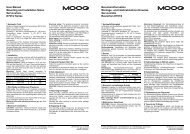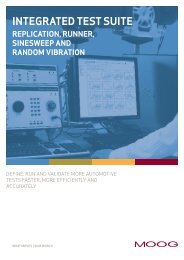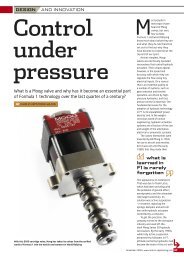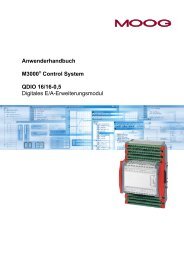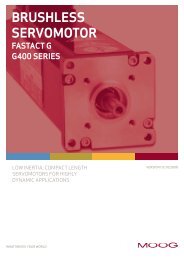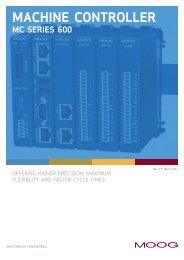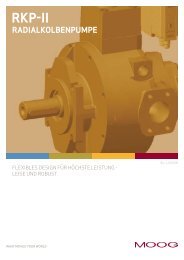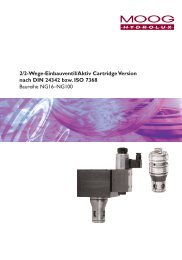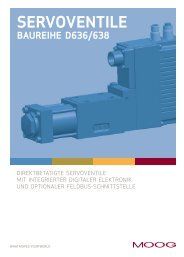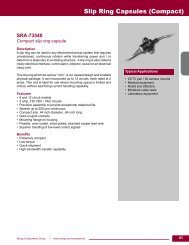User Manual M3000® Automation System / MSC II (Moog Servo ...
User Manual M3000® Automation System / MSC II (Moog Servo ...
User Manual M3000® Automation System / MSC II (Moog Servo ...
Create successful ePaper yourself
Turn your PDF publications into a flip-book with our unique Google optimized e-Paper software.
7 Networking M3000 ® Modules E-Bus<br />
7.6.3.2 Update Rate of E-Bus Messages<br />
WARNING The I/O extension modules QDIO and QAIO monitor the<br />
E-bus activity and disable their outputs if they do not receive<br />
an E-bus message more frequently than 50 ms.<br />
To avoid this, set the value of the system basetick or the<br />
value of 'UpdateRate' so that the product of the two values is<br />
less than 50 ms.<br />
The update rate setting of the E-bus depends on the system basetick. The<br />
system basetick is the time base for the operating system tasks, used in the<br />
application program. Task time bases of tasks can be set to integer multiples<br />
of the system basetick.<br />
The update rate is defined by setting the E-bus module parameter 'Update-<br />
Rate' in the PLC configuration of the MACS development environment.<br />
'UpdateRate' can be set so that an E-bus message will always be sent at the<br />
end of this task's cycle (or after 2, 3, 5, 10, 15 or 20 cycles).<br />
<strong>MSC</strong> <strong>II</strong> Module<br />
Parameter<br />
'Basetick'<br />
E-Bus Module Parameter<br />
'UpdateRate' Update Rate of E-Bus Messages<br />
1 ms 'every third cycle' An E-bus message is started cyclically every<br />
3 ms (1 ms * 3).<br />
3 ms 'every twentieth cycle' An E-bus message would be started cyclically<br />
every 60 ms (3 ms * 20).<br />
However, since no E-bus message is sent<br />
more frequently than 50 ms, the I/O extension<br />
modules will disable their outputs. The outputs<br />
will be re-enabled with the next E-bus<br />
message.<br />
Table 13: Update Rate of E-Bus Messages<br />
7.6.3.3 Duration of Transmission of E-Bus Messages<br />
The duration of transmission of the E-bus message, i.e., the length of time required<br />
to transmit the E-bus message, is determined by the E-bus clock frequency.<br />
The E-bus clock frequency is defined by setting the E-bus module<br />
parameter 'Frequency' in the PLC configuration of the MACS development<br />
environment.<br />
• Clock frequency = 10 MHz � Duration of transmission = 42 µs<br />
• Clock frequency = 5 MHz � Duration of transmission = 84 µs<br />
The selected E-bus clock frequency does not influence the time required to<br />
execute the tasks.<br />
When the E-bus group contains QAIOs 16/4, the clock frequency must<br />
be set to 5 MHz!<br />
When the E-bus group contains QAIOs 2/2, the clock frequency must be<br />
set to 10 MHz!<br />
The duration of transmission of E-bus messages is not influenced by the<br />
number of DIN rail modules in the E-bus group.<br />
E-Bus Communication:<br />
Message Update Rate<br />
E-Bus Communication:<br />
Duration of Message<br />
Transmission<br />
© <strong>Moog</strong> GmbH <strong>User</strong> <strong>Manual</strong> M3000 ® and <strong>MSC</strong> <strong>II</strong> (CA65865-001; Version 1.1, 08/08) 62





